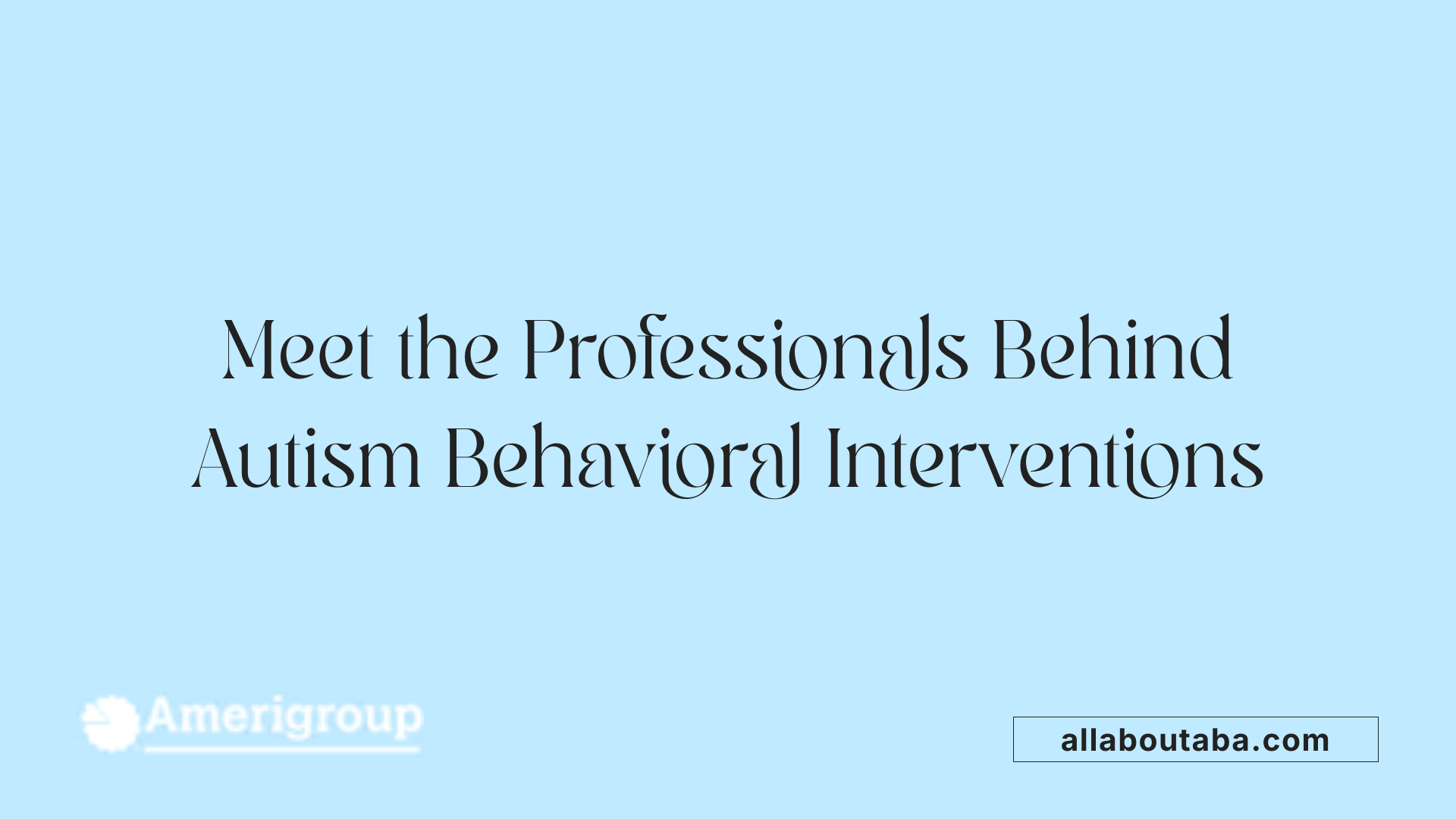Understanding Early Intervention for Autism Spectrum Disorder
Early intervention for Autism Spectrum Disorder (ASD) is a critical step that leverages the developing brain's plasticity to foster social, communication, cognitive, and adaptive skills. Equipped with evidence-based therapies and multidisciplinary approaches, early intervention empowers children with ASD to achieve meaningful progress, improving their quality of life and easing family challenges. This article explores key therapy strategies, including behavioral and developmental approaches, the professionals who provide these services, and how parents and caregivers can engage effectively in supporting their child's growth.
Applied Behavior Analysis (ABA): Cornerstone of Autism Therapy

What is therapy focusing on autism and behavioral analysis?
Therapy focusing on autism and behavioral analysis is primarily Applied Behavior Analysis (ABA). ABA is a scientifically supported method that applies principles of learning and behavior to help children with Autism Spectrum Disorder (ASD) develop social, communication, and learning skills. It encourages desirable behaviors through positive reinforcement and reduces harmful or challenging behaviors by understanding the reasons behind them through detailed behavior analysis.
Definition and principles of ABA
ABA uses a structured approach where behaviors are broken down into smaller, manageable steps. Therapists analyze the antecedents (what happens before a behavior) and consequences (what happens after) to find effective ways to influence behavior. ABA aims to increase independence by teaching new skills systematically with ongoing measurement and adjustment.
Core techniques such as positive reinforcement and behavior analysis
Positive reinforcement is central to ABA. When a child successfully completes a task or behaves appropriately, they receive a desirable reward, encouraging repetition of that behavior. Behavior analysts collect data continuously to track progress and modify plans accordingly for each individual.
Settings and customization of ABA therapy
ABA is flexible and can be adapted to meet the unique needs of each child. It is often delivered one-on-one in settings such as homes, clinics, schools, or community environments. The level of intensity may vary but typically involves several hours a week over several years for sustained improvements.
Evidence supporting ABA effectiveness
ABA is recognized by prominent health authorities as the most extensively validated approach for ASD treatment. Intensive ABA programs have been shown to improve cognitive function, language, IQ, social interaction, and daily living skills in many children. Research supports medium to large effect sizes for behavioral and developmental gains.
Common ABA methods including discrete trial training (DTT) and pivotal response treatment (PRT)
Discrete Trial Training (DTT) involves teaching skills in a step-by-step, instructional manner, ideal for learning specific behaviors. Pivotal Response Treatment (PRT) uses play-based, naturalistic interactions to focus on pivotal skills like motivation and initiating communication—skills that have a broad impact on other areas.
Professional oversight and role of Board Certified Behavior Analysts (BCBAs)
ABA programs are supervised and designed by Board Certified Behavior Analysts (BCBAs), professionals trained in behavior analysis. BCBAs assess the child, set treatment goals, oversee data collection, and ensure interventions meet individualized needs, guaranteeing quality and safety of therapy.
| Aspect | Description | Details |
|---|---|---|
| Therapy Focus | Improving social, communication, and learning skills | Applied Behavior Analysis (ABA) |
| Core Techniques | Positive reinforcement, behavior analysis, breaking skills into steps | Encourages helpful behaviors, reduces harmful ones |
| Methods | Discrete Trial Training (DTT), Pivotal Response Treatment (PRT) | DTT uses structured teaching; PRT uses natural settings |
| Settings | Home, school, clinic, community | Adapted to individual needs |
| Evidence | Supported by extensive research and recognized by health authorities | Improvements in IQ, language, social skills |
| Professional Oversight | Managed by Board Certified Behavior Analysts (BCBAs) | Ensure personalized, data-driven, and safe therapy |
Diverse Behavioral Interventions: Tailoring Therapy to Individual Needs

What is Early Intensive Behavioral Intervention (EIBI) and What Outcomes Does It Show?
Early Intensive Behavioral Intervention (EIBI) is a structured therapy based on Applied Behavior Analysis (ABA) principles. Typically initiated before age 3 and lasting 2 to 4 years, EIBI delivers face-to-face therapy, often in group settings. This approach targets essential skills such as language, cognitive function, self-help, and social interactions.
Research shows that EIBI leads to significant and lasting improvements in IQ, adaptive behaviors, and both receptive and expressive language. Effect sizes reported in studies range from medium to large, highlighting its impact on the developmental trajectory of young children diagnosed with autism spectrum disorder (ASD).
What is Naturalistic Developmental Behavioral Intervention (NDBI) and the Early Start Denver Model (ESDM)?
Naturalistic Developmental Behavioral Intervention (NDBI) combines behavioral techniques with developmental approaches to promote learning in everyday settings. It focuses primarily on social and communication skills.
The Early Start Denver Model (ESDM), a well-studied NDBI, is designed for children aged 1 to 4 years. It enhances social, emotional, cognitive, and language development while reducing ASD symptoms. ESDM therapy is delivered during play and daily routines by trained therapists and family members, emphasizing natural interactions that support growth.
Studies demonstrate moderate effect sizes for ESDM, showing improvements in IQ and social-communication skills.
How Does Pivotal Response Treatment (PRT) Utilize Play-Based Methods?
Pivotal Response Treatment (PRT) is a play-based form of ABA focusing on pivotal behaviors, including motivation and initiation of communication. Conducted both in clinics and home settings, PRT emphasizes consistent engagement by all individuals involved in the child’s life.
By encouraging spontaneous communication and social interactions during play, PRT improves not only pivotal behaviors but also broader social, communication, and academic skills.
What Are Reciprocal Imitation Training and Its Milestone Targets?
Reciprocal imitation training (RIT) is a naturalistic intervention where therapists and caregivers imitate an individual’s actions, encouraging the child to imitate back. This mutual exchange aims to enhance early social communication milestones including joint attention, turn-taking, and imitative play.
Targeting these foundational social interactions supports the development of language, play skills, and emotional connectivity, providing building blocks for more complex social behavior.
Why is Early Intervention Critical, Especially Before Age 3?
Early intervention, ideally before the age of three, leverages the brain’s plasticity during early development, maximizing the chance for positive outcomes in children with ASD. Early therapies focus on foundational skills like imitation, following directions, and responding to environmental cues.
Intervening early can significantly enhance social, communication, and cognitive skills, reduce behavioral challenges, and facilitate smoother adaptation to learning environments.
What Role Do Parent-Mediated Interventions Like JASPER and Adapted ESDM Play?
Parent-mediated interventions empower caregivers to actively participate in their child’s therapy. Programs such as JASPER (Joint Attention, Symbolic Play, Engagement, and Regulation) and parent adaptations of ESDM provide caregivers with training to promote social interaction, communication, and reduce autism symptoms at home.
These interventions improve social engagement, decrease challenging behaviors, and even reduce parental stress. The accessibility of parent-led therapy—sometimes via telehealth—makes it a valuable complement to professional services and supports real-world application of strategies.
Through these diverse behavioral interventions, individualized therapy addresses the unique needs of children with ASD, optimizing developmental outcomes by leveraging scientific insights and family involvement.
Developmental and Educational Approaches to Enhance Autism Therapy

How do developmental methods target language, motor, and cognitive skills in autism therapy?
Developmental approaches focus on improving specific skill areas such as language, motor coordination, and cognitive functioning. These methods include tailored interventions that emphasize enhancing expressive and receptive language abilities, fine and gross motor skills, and adaptive functioning essential for daily life. Such interventions typically engage children in natural settings to promote spontaneous skill use.
What role does speech and language therapy (SLT) play, and how do naturalistic and augmentative communication models support children?
Speech and language therapy is a common developmental intervention aimed at improving understanding and expression of speech and language. Techniques include naturalistic approaches, which encourage communication during everyday interactions, and augmentative and alternative communication (AAC) systems like Picture Exchange Communication System (PECS), helping children initiate conversations or request needs through pictures or devices.
How does occupational therapy assist individuals with ASD in daily living, and what is the importance of sensory integration?
Occupational therapy supports children with autism in acquiring skills necessary for independent living—such as dressing, eating, bathing, and social skills. Sensory integration therapy, often part of occupational therapy, helps children regulate and respond to sensory stimuli, managing hypo- or hypersensitivities that affect daily functioning.
What does physical therapy address for children with autism?
Physical therapy is used to improve gross motor skills, balance, and coordination. It complements occupational therapy by targeting large muscle groups and motor planning abilities, which are sometimes challenging for children with ASD.
How do educational interventions like the TEACCH approach support students with autism?
The TEACCH approach creates structured classroom environments tailored to children with autism. It emphasizes visual routines, clear boundaries, and predictability, making use of visual supports to enhance understanding and reduce anxiety. Consistency and clear expectations facilitate learning and adaptation.
In what ways are social stories and visual timetables used to help children with autism?
Social stories and visual timetables serve as visual aids that teach social cognition, daily routines, and appropriate behaviors. They help children grasp social expectations and manage transitions smoothly by providing concrete cues and schedules, although further research is needed to fully establish their effectiveness.
| Intervention Type | Focus Area | Description |
|---|---|---|
| Developmental Methods | Language, Motor, Cognitive Skills | Targeted skill-building in natural contexts to promote communication and coordination |
| Speech and Language Therapy | Communication | Uses naturalistic models and AAC systems to improve expressive and receptive language skills |
| Occupational Therapy | Daily Living & Sensory Integration | Teaches self-care and social skills; addresses sensory regulation challenges |
| Physical Therapy | Gross Motor Skills | Enhances balance, strength, and coordination |
| TEACCH Educational Approach | Structured Learning Environment | Employs visual routines and boundaries to support consistent learning in classrooms |
| Visual Supports | Social Skills and Routine Management | Includes social stories and visual timetables to aid comprehension and behavior |
Social Skills and Relational Interventions: Building Connections

What are social-relational models like DIR Floor Time and Relationship Development Intervention (RDI)?
Social-relational interventions such as DIR Floor Time and RDI focus on enhancing emotional bonds and communication through play-based, reciprocal interactions. DIR Floor Time encourages children to engage in meaningful play at their developmental level, while RDI targets improving motivation, social communication, and flexible thinking by involving parents and caregivers consistently.
How effective are social skills training (SST) programs?
Social skills training programs have demonstrated consistent effectiveness across age groups for improving social responsiveness. They often employ structured methods with clear goals, and meta-analyses reveal medium to large improvements in skills like initiating conversations, understanding social cues, and cooperative play.
What role does group-based instruction and peer interaction play?
Group settings allow children with autism to practice social behaviors with peers in real-time, promoting generalization of skills beyond therapy. These social contexts foster natural communication, teamwork, and conflict resolution abilities, which are essential for building friendships.
What techniques enhance social skills in these programs?
Role-playing exercises help children rehearse social scenarios and appropriate responses. Video and computer-assisted training offer engaging ways to identify emotions and nonverbal cues, reinforcing learning through repetition and visual feedback.
How do these interventions impact understanding emotions, nonverbal cues, and managing bullying?
These interventions improve recognition of facial expressions, tone of voice, and body language, which aids children in interpreting others' feelings. Increased social competence also equips them with strategies to handle bullying by fostering resilience and assertiveness.
This comprehensive approach strengthens social connections and supports the development of meaningful relationships for individuals with ASD.
Role of Therapy Providers: Who Delivers Autism Behavioral Treatments?

Who Provides Therapy Services for Autism and Behavioral Analysis?
Therapy services for autism are delivered by a range of trained professionals, including Board Certified Behavior Analysts (BCBAs), speech-language pathologists, occupational therapists, psychologists, and behavioral specialists. BCBAs lead Applied Behavior Analysis (ABA) therapy, the most evidence-supported behavioral treatment for autism spectrum disorder, focusing on shaping positive behaviors, communication, play, and social skills.
How Do Interdisciplinary Teams Collaborate in Autism Treatment?
Effective autism therapy often involves interdisciplinary teams combining expertise from behavioral analysts, therapists, and medical professionals. This collaborative approach ensures a comprehensive treatment plan that addresses the child's developmental, communicative, sensory, and social needs. Such teams coordinate assessments, set personalized goals, and continuously monitor progress.
What Training Do Parents and Caregivers Receive?
Parents and caregivers are trained alongside professionals to apply behavioral strategies consistently in daily life. Parent-mediated interventions empower families to reinforce communication and social skills, reduce challenging behaviors, and support generalization of skills. Telehealth platforms increasingly facilitate training and ongoing support, enhancing accessibility for many families.
Where Are Autism Behavioral Treatments Delivered?
These services are provided in specialized centers, school programs, clinics, and community-based settings. Flexibility allows therapy sessions at home or in natural environments, promoting more functional learning and social interaction. Parent participation is a vital part of many programs to maximize effectiveness.
Why Are Professional Qualifications and Supervision Important?
Qualified providers, such as BCBAs and licensed therapists, ensure evidence-based interventions are implemented safely and effectively. Supervision by experts helps tailor treatments to each individual’s needs and maintains high standards. Families are encouraged to ask providers about credentials, treatment goals, and progress monitoring.
How Does Parental Engagement and Telehealth Support Work?
Parental involvement in therapy enhances outcomes by promoting skill generalization and consistency. Telehealth models enable therapists to coach parents remotely, increasing convenience and extending services to underserved or rural areas. Research supports telehealth’s efficacy in reducing challenging behaviors and improving family satisfaction.
| Provider Type | Role | Setting of Service |
|---|---|---|
| Board Certified Behavior Analyst (BCBA) | Develops and oversees ABA programs | Clinics, homes, schools |
| Speech-Language Pathologist | Improves communication and language skills | Therapy centers, schools |
| Occupational Therapist | Teaches daily living and sensory integration skills | Clinics, home, community settings |
| Psychologist | Supports emotional and behavioral health | Specialized clinics, schools |
| Parents/Caregivers | Implement strategies daily, generalize skills | Home, community |
Professional collaboration, parental training, and flexible service delivery form the backbone of effective autism behavioral interventions, ensuring tailored support for children and families.
Addressing Co-Occurring Challenges through Behavioral and Medical Supports

How are associated issues such as sleep problems, eating behaviors, and toileting managed in individuals with ASD?
Management of co-occurring challenges in autism spectrum disorder (ASD) often involves specialized behavioral interventions tailored to these specific issues. For example, sleep problems are addressed using behavioral strategies such as fading bedtime routines, extinction, and scheduled awakenings, which have proven effective in improving both sleep duration and quality.
Eating behaviors, especially food refusal and selectivity, respond well to behavioral methods like contingent reinforcement and the non-removal of the spoon (NRS) technique. These approaches encourage acceptance of a wider variety of foods and reduce challenging eating behaviors.
Toileting challenges are tackled through structured programs that employ shaping, graduated guidance, scheduled toileting, and stimulus control. Rapid toilet training (RTT) protocols, in particular, have shown success for children aged 3 to 12 years, facilitating quicker mastery of toileting skills.
When are medications used for co-occurring symptoms in ASD?
While no medications currently treat the core symptoms of ASD, pharmacological interventions may be prescribed to manage co-occurring symptoms such as anxiety, depression, seizures, hyperactivity, self-injury, sleep disturbances, and gastrointestinal issues. These medications are used cautiously and always under medical supervision to ensure safety and appropriate dosage.
What is the role of Cognitive Behavioral Therapy (CBT) for emotional and mental health challenges?
Cognitive Behavioral Therapy (CBT) is an effective behavioral approach used primarily in adolescents and adults with ASD to manage emotional difficulties like depression, anxiety, and anger. CBT provides strategies to understand and cope with these feelings and has shown favorable outcomes, although access to qualified providers may be limited in some regions.
Together, these behavioral and medical supports form a comprehensive framework for addressing the complex and varied needs of individuals with ASD beyond core symptoms, improving overall quality of life.
Parental Involvement and Training: A Vital Component of Intervention

What are Parent-Mediated Interventions and Their Benefits?
Parent-mediated interventions (PMI) involve training parents to implement therapy techniques with their children, enhancing social interaction, language skills, and reducing core autism symptoms. Programs such as the Early Start Denver Model adapted for parents have shown effectiveness, providing an accessible option that integrates therapy directly into daily routines.
How Are Parents Trained in Behavior Management, Communication Strategies, and Advocacy?
Parents receive guidance in managing challenging behaviors, fostering communication, and advocating for their child’s needs. Training encompasses behavior management techniques based on Applied Behavior Analysis (ABA), communication methods including augmentative systems, and strategies to navigate educational and healthcare systems.
What Is the Impact of Parental Training on Challenging Behaviors and Stress?
Studies indicate that PMI can significantly reduce aggression, self-injury, and hyperactivity in children with ASD. Importantly, parent training also decreases parental stress by empowering caregivers with skills and confidence, leading to improved family well-being.
How Does Telehealth Enhance Accessibility to Parent Training?
Telehealth delivery has expanded access to PMI, especially for families in remote or underserved areas. Virtual sessions enable continuous coaching, progress monitoring, and support, allowing parents to apply therapy techniques consistently and effectively at home.
Why Is Consistent Application of Therapy Techniques at Home Encouraged?
Consistency across home and therapy settings reinforces skill acquisition and generalization. When all caregivers participate in applying strategies, children experience a coherent learning environment that accelerates developmental progress.
How Does Parental Involvement Support Family Dynamics?
Education and empowerment of parents improve family interactions and reduce stress associated with caregiving. Engaging families as active therapy partners fosters a supportive environment that benefits not only the child with ASD but the entire household.
Maximizing Outcomes: Early, Individualized, and Comprehensive Intervention Plans

Why Start Intervention Before Age 3?
Early intervention, ideally before the age of three, is vital given the brain's plasticity during this period. Programs introduced early can notably improve social communication, cognitive skills, and language development, laying a strong foundation for future learning.
What Does a Multidisciplinary Approach Offer?
Successful treatment plans blend behavioral, developmental, and educational therapies. This includes Applied Behavior Analysis (ABA) to enhance communication and social skills, speech and language therapy to support communication development, occupational and physical therapies for daily living and motor skills, and educational methods like TEACCH for structured learning environments.
How Are Treatment Goals Assessed and Adjusted?
Regular assessment is crucial. Progress is continuously monitored by qualified professionals such as behavior analysts and therapists. Treatment goals are personalized and modified as needed to reflect improvements or emerging needs, ensuring that interventions remain effective and relevant.
What About Insurance and Access?
Access to therapies often depends on geographic location and insurance coverage. Many insurance plans, including Medicaid in some areas, cover medically necessary autism treatments like ABA, sometimes up to 40 hours per week. Furthermore, programs under the Individuals with Disabilities Education Act offer free educational services to eligible children.
How Are Therapies Integrated Across Settings?
Effective intervention spans home, school, and community. Therapies are often delivered in multiple settings to promote generalization of skills. Parents and caregivers are actively involved, with parent-mediated interventions enhancing consistency and extending treatment benefits beyond the clinic.
Why Individualize Intervention?
Each child with ASD has unique strengths and challenges. Personalized plans focus on improving social communication, self-care, behavior, and academic skills aligned with the child's needs. This individualized approach maximizes progress and supports overall development.
This comprehensive, early, and individualized framework supports children with autism in achieving meaningful and lasting improvements across key life areas.
Shaping Brighter Futures through Early and Evidence-Based Autism Interventions
Early intervention for children with Autism Spectrum Disorder harnesses the power of evidence-based therapies like Applied Behavior Analysis alongside developmental, educational, and social approaches to promote meaningful gains in communication, social skills, and independence. Supported by a diverse team of skilled professionals and bolstered by active parental involvement, these therapies maximize developmental potential during critical early years. As research advances and access to services improves, families and children stand to benefit profoundly, underscoring the importance of early diagnosis, comprehensive planning, and sustained, personalized treatment programs.
References
- Treatment and Intervention for Autism Spectrum Disorder
- Behavioral Therapy for Autism Spectrum Disorder in Children
- Behavioral Interventions for Autism Spectrum Disorder
- Applied Behavior Analysis (ABA)
- Early Autism Intervention Strategies | ABA ...
- Intervention Approaches Used for Children With Autism ...
- Autism Therapy Types & Interventions







